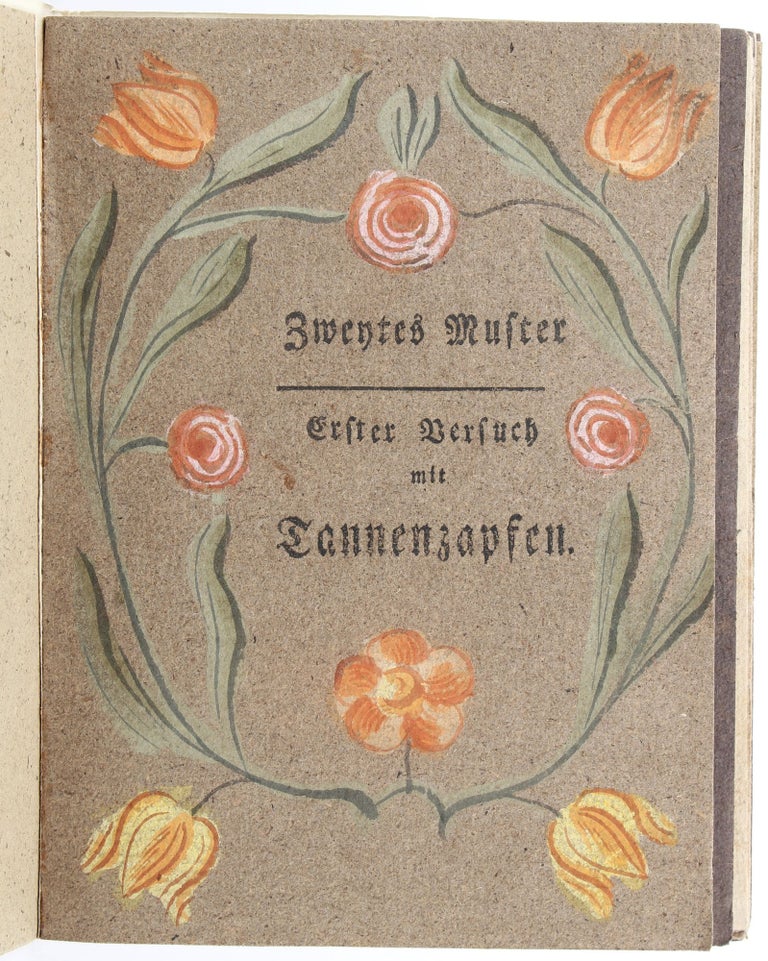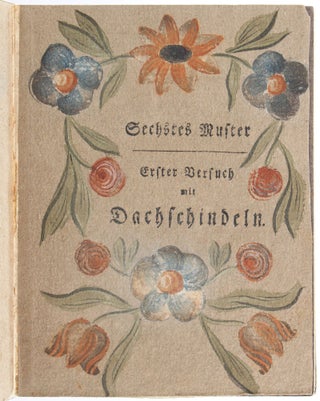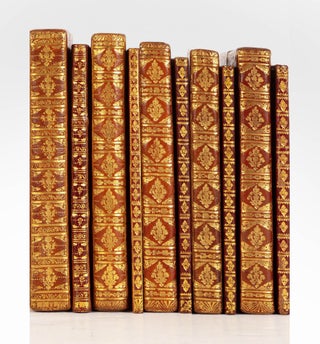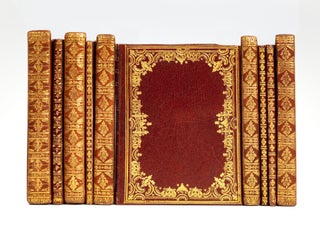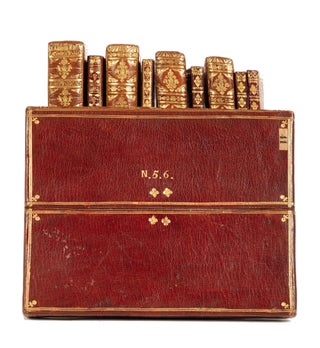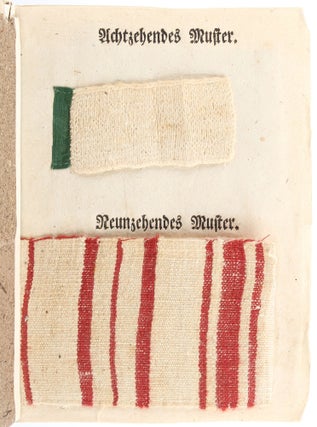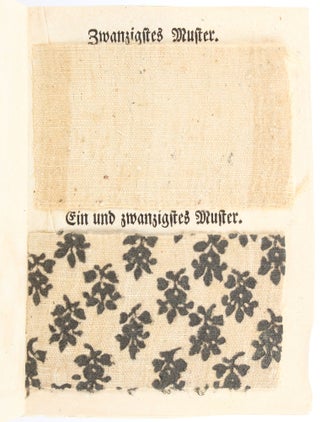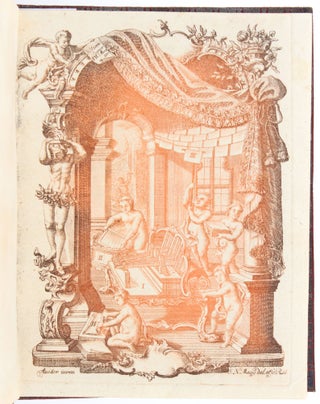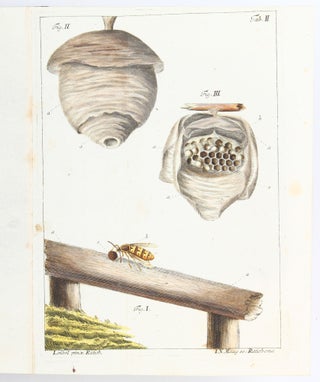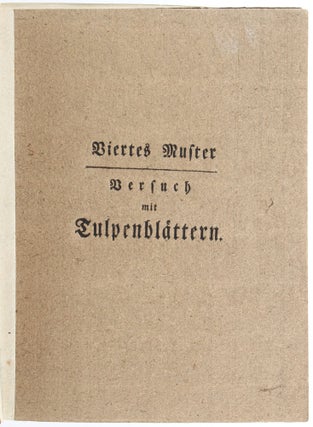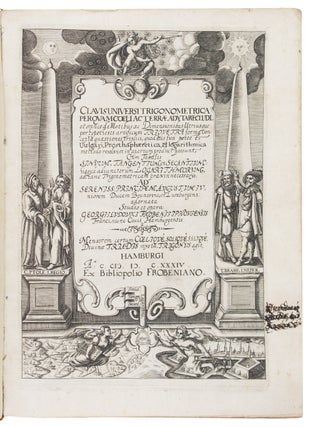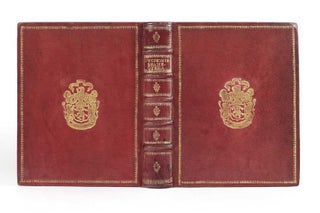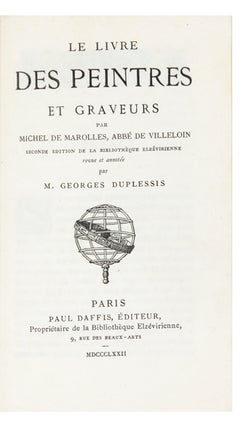“The Rarest Work on the Specific Subject of Paper that has ever been Published”–Dard Hunter
Versuche und Muster ohne alle Lumpen oder doch mit einem geringen Zusatze derselben Papier zu machen.
Vol. I: Engraved frontis. printed in bistre, four hand-colored engraved plates of alternative materials used in making paper. Separate atlas with printed drop-title & 15 leaves of specimens. 6 p.l., 54 pp. Vol. II: Separate atlas with printed drop-title, 19 leaves of specimens, & one hand-colored engraved plate. 6 p.l., 28 pp. Two vols. Small 4to (195x 150 mm.), all vols. uniformly bound in richly gilt contemporary red morocco, covers with large gilt decoration in Rococo style, flat spines gilt, each text and respective atlas in fitted, richly gilt & tooled cont. red morocco slipcases. Regensburg: 1765.
[with]:
—. Neue Versuche und Muster das Pflanzenreich zum Papiermachen und andern Sachen wirthschaftsnützlich zu gebrauchen. Vol. III: Engraved frontis. printed in indigo & two hand-colored engraved plates (laid-in). Separate atlas with printed drop-title & 21 leaves of specimens, four of which are cloth (the first paper specimen is a large fragment). 6 p.l., 32 pp. Vol. IV: Separate atlas with printed drop-title, 13 leaves of specimens including one made from lace, & one hand-colored engraved plate. 4 p.l., 24 pp. Vol. V: Five engraved folding plates of papermaking machinery. Separate atlas with printed drop-title & nine leaves of specimens (several with orig. hand-coloring). 22 pp. Small 4to, bindings as above. Three vols. Regensburg: 1765-66-67.
[bound with]:
—. Wiederholte Versuche auf ordentlichen Papiermühlen aus allerhand Pflanzen und Holzarten Papier zu machen. Der sämtlichen Versuche Sechster und lezter Band. Separate atlas with printed drop-title & ten leaves of samples. 2 p.l., 16 pp. Small 4to. Regensburg: 1771.
First editions and a magnificent set in contemporary red morocco, with each volume preserved in contemporary red morocco slipcases. I have been looking and waiting for a complete copy for 45 years, and this set is absolutely remarkable: complete and luxuriously bound.
The best modern account of this complex book is from the catalogue of the papermaking exhibition held at the Free Library of Philadelphia (15 April-15 June 1968), which featured the great paper collection of Leonard B. Schlosser: “Issued in six volumes over a six year period, this work is the first carefully documented research into the use of materials other than rags for the manufacture of paper in the West. Schäffer’s ideas may well have germinated from the writings of Réaumur (1719) and Guettard (1741) who suggested wood and other natural fibers as possibilities for paper, but his work was carried on independently and helped by his considerable abilities as a naturalist. Each of the six volumes of his work on paper contains detailed explanations of the materials and methods used for the experiments as well as a set of the samples produced. The samples have been printed upon, and some have been painted on by Schäffer’s daughter, in order to demonstrate their utility. The engravings included in some of the volumes show some of the fiber sources as well as the equipment used to prepare the fiber for papermaking. In all, the six volumes contain 176 pages of text and eighty-seven specimens (Hunter [incorrectly] says ninety-five) including four pieces of cloth and one of lace. There are fourteen plates and one engraved frontispiece.”–Leonard B. Schlosser, An Exhibition of Books on Papermaking (Philadelphia: [Printed in 300 copies at the Bird & Bull Press], 1968), no. 17.
The samples comprise full-page specimens, with descriptive letterpress captions, of paper made from various materials: wood and/or bark of beech, willow, aspen; hops; grapevines; mulberry; clematis; nettles; various mosses; poplar-seed down; hemp chaff; straw; aloe and tree leaves; cattails; cabbage stalks; burdock; pine cones; lily-of-the-valley leaves; leaves and husks of maize; asbestos; wasps’ nests; sawdust; seeds of cotton grass and thistles; skin and pulp of potatoes; and mixtures of scraps from the various other experimental papers.
Fine set. Bookplate of A. Lanna. Adalbert Freiherr von Lanna (1836-1909), a Czech industrialist and collector, formed one of the most remarkable private libraries in Mitteleuropa of the late 19th century. This copy of the Schaeffer appeared as lot 331 in one of Lanna’s sales in Vienna (Gilhofer & Ranschburg, 3-4 April 1911), purchased for 90 krone. With thanks to Jamie Cumby, the Grolier Club Librarian, for this information.
❧ Dard Hunter, Papermaking through Eighteen Centuries (1930), p. 54–”This is the rarest work on the specific subject of paper that has ever been published…In his six volume treatise Dr. Schäffer has left a permanent record of his experiments in the search for new papermaking materials, and the actual specimens of his paper establish the fact that he was the pioneer in the use of many vegetable fibres for the fabrication of paper…A number of specimens are sized, and nearly all have been printed upon, showing from what plant or fibre they had been made.”–(& see pp. 53-68 for an extended account of this book).
Dard Hunter, The Literature of Papermaking 1390-1800 (1925), pp. 34-36.
Price: $90,000.00
Item ID: 8841

